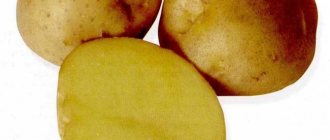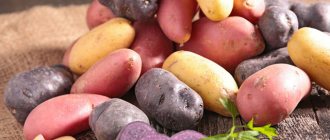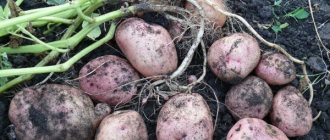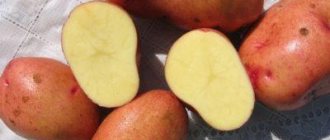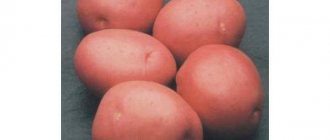The photo shows elite mini-tubers for planting two wonderful Irish potato varieties. When planted, such tubers give full-fledged bushes.
Irish potatoes stand out from the general background - the shoots are powerful, the potato bushes are very good, just a sight for sore eyes, and the harvest is magnificent, always very high.
Potato Banba
Banba is a very tasty and beautiful potato variety, named after the legendary Queen of Ireland. The tubers are large, round-oval, the skin is yellow, mesh with small eyes. The pulp is light yellow and tasty.
These potatoes are amazingly tasty when fried. French fries are excellent; it’s hard to find a better variety for making fried potatoes!
The bush is medium-sized, with dark green leaves, long-lasting flowering, white flowers. Tolerates drought very well.
The tubers are resistant to mechanical damage, store well, and do not germinate during storage.
Resistant to scab and late blight.
The productivity is very high.
Burren Potatoes
The name Burren is given in honor of the most picturesque corner of Ireland's nature. The tubers are very attractive in appearance, beautiful, aligned, elongated oval. The peel is smooth, yellowish-cream with small eyes. The pulp is yellow and tasty.
A tall bush with light green leaves and white double flowers.
Relatively resistant to drought, stores well, does not germinate for 8 months or longer.
Thanks to its early ripening, the variety avoids autumn rains and temperature changes, avoiding late blight.
The productivity of this variety is incredibly high.
Why are Irish potatoes so good?
Ireland is especially famous for its potatoes; this is the main crop on which the people of this country live. It’s no wonder that so many delicious potato dishes are Irish.
Potatoes have been known in Ireland since the late 16th century. Here it gained considerable popularity because it gave a good harvest; in the humid and mild climate of the island it grows even on infertile soils. Potatoes were used as food for people and as feed for livestock. In the 19th century, about two-thirds of potatoes grown were destined for human food. Potatoes make up virtually the entire daily diet of the average Irish person.
The Irish began to pay special attention to potato varieties after the great famine. As a result of famine and epidemics, from 500 thousand to 1.5 million people died.
The Great Irish Famine (also known as the Irish Potato Famine)
) occurred in Ireland in 1845-1849. The famine was triggered by an epidemic of the potato pathogen Phytophthora infestans, which causes late blight. In 4 years, the potato harvest failed three times due to late blight, and in the year that potatoes did grow, there were too few plantings to feed ourselves.
Since then, the fight against potato diseases and pests has been one of the tasks of Irish breeding. And Irish potato varieties today are practically unrivaled - in terms of yield, growth vigor, and resistance to various potato diseases.
In which store can you buy everything, what are the prices for onions and potatoes?
Potatoes "Banba": features of the variety (video)
At the next stage, potato tubers are germinated and greened, and then treated with special chemicals:
- “Binoram” – treatment of tubers three days before planting at the rate of 1 liter for every kilogram of potatoes;
- “Planriz” – treatment of tubers a week before planting at the rate of 1 liter per 100 kg of potatoes;
- “Gamair” – pre-planting treatment of tubers at a rate of 2 liters per 1 ton of potatoes;
- “Alirin-B” – pre-planting treatment of tubers with a rate of 10-15 liters per 1 ton of potatoes.
In addition, it is advisable to spray the soil, and, if necessary, plant residues after harvesting the previous crop with Sternifag.
The area for planting potatoes should be dug to a depth of 27-30 cm, and on soils with a smaller arable horizon, digging should be done to the full depth with additional subsurface loosening.
The optimal planting time should be selected. With late planting, both the yield and the average starch content of potatoes sharply decrease.
Burren potatoes variety description photo reviews
The answer to the question why we increasingly prefer Dutch seeds, be it potatoes, cucumbers or tomatoes, is extremely simple. This country with a cool climate is a leader in the production of high-quality planting material. Potato varieties (Dutch) are some of the best. They are exported to more than 70 countries. Their productivity breaks all records. Suffice it to say that in Russia, about 100-140 kg of potatoes are harvested from a hundred square meters, while the Dutch get at least 400 kg from it. This fact is already enough to make you think about buying. We bring to your attention the most popular potato varieties (photos and descriptions) from Holland.
Harvesting and storage
The first harvest of young Banba potatoes can be done already 70 days after germination, i.e. at the end of July. For winter storage, the crop is dug up in the first half of August. Choose a warm and dry day. Two weeks before this, it is advisable to mow the tops to 10 cm so that the root crops have time to gain mass.
The collected potato tubers are shaken off the ground and allowed to dry in the sun for several hours. Then they are packed into bags and sent to a dark room. For the first two weeks they are stored at temperatures up to +14–15 °C, and then at +2–5 °C and humidity 70–80%. Damaged, small and largest root vegetables are best consumed first.
Banba potatoes can be stored on wooden shelves or in bags
Attention! Harvesting should not be delayed. Otherwise, the peel may become rough, which will deteriorate the presentation of the root vegetables.
Variety "Sante"
A very productive variety of medium ripening (80-90 days) of Dutch selection. It is actively used to create table dishes, in particular for preparing French fries and chips.
The bush grows compact, of medium height, and erect. Due to the high yield, a significant distance must be left between individual plants. The tubers are large, characteristically oval in shape, with a smooth yellow skin and numerous eyes. The pulp is pale yellow in color with a starch content of 10-14.2%, high quality taste.
Irish potatoes
Recently, old potato varieties have begun to bear fruit poorly, and acquiring new ones in the outback, as you understand, is problematic. Therefore, last spring I decided to order mini-tubers of super-elite varietal potatoes via the Internet.
The catalog indicated that, despite their small weight (15-20 g), already in the year of planting they produce full-fledged tubers. And in the next few years, yields will remain at a high level.
In January, I ordered early-ripening potato varieties - Kamensky, Lider, Fantasia, Charodey, Lazar variety (medium ripening) and late-ripening ones - Lasunok, Bryansky reliable. As well as Irish early varieties - Banba, Electra, Burren.
Interestingly, the varieties Kamensky, Lasunok and Bryansky Reliable were characterized as resistant to damage by the Colorado potato beetle due to their tougher, pubescent leaves. I really wanted to test this in practice.
I received mini tubers in early April. I soaked them in a pink solution of potassium permanganate for 30 minutes and laid them out in the light for germination. And before transporting to the site, in order not to damage the sprouts, I carefully placed the potatoes in empty egg containers. I planted it in early May. A handful of ash and crushed eggshells were added to each hole. I planted potatoes in rows, according to varieties, and sowed mustard in the spaces between the rows. In autumn and spring, I did not add fertilizer to the soil, so at the same time as the first hilling, I watered the sprouts with a well-diluted aqueous infusion of nettles and chicken droppings.
At the beginning of June, I cut the mustard and laid it around the grown potato bushes, covering the emerging tubers. To restore soil fertility, oats were sown between the rows. Later, instead of hilling, I placed weeded and dried weeds under the potato bushes. This mulch retains moisture after watering and protects the soil from overheating during the July heat. Unfortunately, varieties that were advertised as resistant (they were mentioned above) were also attacked by the Colorado potato beetle. Therefore, the area still had to be treated for the pest.
Irish early varieties have proven themselves best. They immediately stood out against the general background with their tall, powerful shoots. Electra collected 14 potatoes from one bush. And the mini-tuber of the Burren variety ultimately yielded 1.2 kg of yield.
Tatiana PONOMAREVA, Stary Oskol
Source: Gardener and Gardener magazine
belagrotorg.ru
Variety "Red Scarlett"
An early variety with a very high yield of Dutch selection. In the southern regions of the country, the harvest takes place within 45 days.
The smooth, oblong tubers are red in color and weigh 90-150 g, the surface is smooth with a small number of eyes, the starch content in them is 10-15%.
One of the main advantages is good drought tolerance and resistance to many viral diseases.
Variety "Impala"
A very early, high-yielding variety that allows you to harvest two harvests in the summer in the southern regions.
The bush is tall, tall (up to 75 cm), with powerful 4-5 stems, erect. Oval-shaped tubers with yellow skin and pale yellow flesh have a small number of small eyes, starch content 10-14%, weight on average 90-150 g.
Dutch potatoes of this variety are characterized by good keeping quality and high resistance to bacterial and viral diseases.
Tubers gain weight quite quickly, on average in 50 days, have a beautiful, marketable appearance and high taste.
Description of varieties
It is believed that prolonged ripening increases the starch content in tubers, and therefore these potatoes are tastier. Ultra-early varieties have a less intense potato taste than mid-late and late varieties.
White pulp indicates a high content of starch and vitamin C. Such tubers are better boiled, they are more juicy, among them are Petersburg, Silvana and Leader.
Interesting! Small and medium potato tubers contain more nutrients than large ones.
White tubers with white pulp are considered the most popular for making puree; such a dish will be crumbly, tender and tasty. It is better to use varieties such as Barin, Lakomka and Milena.
Difference from other varieties
First of all, these varieties are distinguished by the presence of white pulp, which ensures better cooking and a mild taste of mashed potatoes. A large amount of starch gives the tubers a special taste, which varies among varieties:
- Master – has a beige skin and light flesh, starch content reaches 15%, the taste is sweet and delicate.
- Leader – characterized by a yellow tint of the peel and white flesh, the taste is highly rated.
- Petersburg is a mid-season table variety with white flesh and skin, not prone to darkening when cooked.
- Milena is an ultra-early potato that does not become overcooked, the skin is yellow, and the flesh has a creamy tint.
- Timo – the smooth skin of the potato has a yellowish tint, the flesh is light with good taste, the starch content is up to 14%.
- Gourmand – the taste of this variety is highly rated. Characteristic features: mid-early ripening, smooth yellow skin and white flesh.
In addition, there are a number of varieties with white flesh, which differ in the color of the skin - red, pink, yellow and purple, as well as the shades of the eyes.
Among them are the following famous varieties:
Milena
- Sineglazka;
- Picasso;
- Rocco;
- Rosara;
- Red Scarlett;
- Purple Haze;
- Bullfinch;
- Chugunka and others.
All varieties of white-fleshed potatoes have high nutritional value and contain large amounts of vitamins and microelements.
Chemical composition, trace elements and vitamins
It is the white-fleshed potato varieties that contain large amounts of the valuable vegetable protein tuberin. They are also distinguished by their high content of vitamins C, A, E, K, B and H.
The presence of acids such as nicotinic, malic and oxalic make potatoes an assistant for diseases of the heart and blood vessels. Pantothenic and citric acids will help fight kidney disease.
Characteristics of tubers and yield
Depending on the variety, the size and surface of the tubers may differ, as well as their number under one bush:
- The leader has a regular tuber shape, oval with thin skin, smooth. The highest yield is 340 c/ha.
- St. Petersburg potatoes are distinguished by a flat top tuber and a smooth surface. You can harvest up to 4 kg of potatoes from one bush.
- Milena ripens early, the tubers are large and round. Maximum yield – 600 c/ha.
- Lakomka is an ultra-early variety with round potatoes. Harvest up to 369 c/ha.
For the most part, potatoes grow in medium and large sizes, the yield of varieties with white flesh is high, and the quality of the pulp and taste are always at their best.
Region for cultivation and planting dates
It is believed that potatoes are best grown in central Russia; this climate is most suitable for the plant. In the southern regions, as in the northern ones, the quality and quantity of vitamins and microelements will differ. As a rule, they decrease due to too hot or cold climate and the number of sunny days.
Potatoes are planted in early May, but depending on the region, the dates may shift. The further south the region is, the earlier the tubers are planted and the earlier the harvest is harvested . In the northern regions, potatoes are planted only after the onset of stable heat, when the soil warms up from +10°C and above.
Variety "Picasso"
Medium-late ripening potatoes of Dutch selection with outstanding taste and long shelf life.
The plant is powerful, tall, with abundant flowering. The oval tubers have a thin yellow skin with pink spots.
Gives a stable and abundant harvest. However, it is sensitive to poor soils; similar potato varieties (Dutch, etc.) require an increased rate of fertilizer to be added to the soil. Resistant to drought and high air temperatures, viruses, potato nematode, scab, fusarium, late blight of tubers and tops.
How to harvest and store crops
Banba is removed only when the bushes turn yellow and begin to wither. Lateness is fraught with rapid spoilage during storage.
After digging, the tubers are laid out in one layer in a dry place to dry for 2 weeks. Then the potatoes are sorted, rejecting limp and damaged roots.
Store in the basement in boxes covered with sawdust. For this variety, the humidity should not be very high. Storage temperature is required within 2-3 °C. Keeping quality is high, up to 96%.
Variety "Condor"
Introduced into culture since 1995. Early variety, table variety.
The bush is powerful, erect, tall. The flowers of the plant are rich, dark red with a purple tint. The oval tubers have an even shape with a red skin and light yellow pulp, the starch content ranges from 9-14%.
It is characterized by average resistance to viruses, common scab, and susceptibility to late blight. The variety is valued for its high and stable yield and high marketability of tubers.
Variety "Desiree"
Mid-late ripening potatoes. The bush is tall, spreading, with rich green tops. Oval-shaped tubers with thin red skin and light yellow pulp, weighing on average up to 100 g. Increased starch content - 13.5-21%.
It is characterized by high taste and is widely used for making chips.
Many modern potato varieties, especially Dutch ones, are resistant to drought and various diseases. “Desiree” has average indicators in this regard; it is susceptible to late blight and scab above average. However, it is highly productive and has excellent commercial qualities.
Variety "Yarla"
Dutch early potatoes for table use. The bush is spreading and tall, the flowers are white. The tubers have an oval-round shape with yellow skin and pulp, small eyes. Weight - from 85 to 310 g, high taste, starch content - 12-18%.
This variety allows you to get a bountiful harvest in a short growing season. Rapid ripening provided it with resistance to late blight and rust, scab, and cancer. It develops well in a wide variety of soils; it is not afraid of return frosts - after them the plant quickly returns to normal. The variety is exceptionally unpretentious and reliable.
Features of care
Potatoes of the "Banba" variety require minimal care and, according to some data, show good yield even when grown by beginner, inexperienced gardeners. Knowledge of the basic characteristics of the plant and adherence to agricultural technology will help ensure high potato yields and obtain tubers with high quality characteristics.
- Indicators of the size of the harvest and its quality strongly depend on the water-physical properties of the soil, as well as its fertility.
- The soil should be loose, air- and water-permeable, moisture-absorbing, highly cultivated, which is typical for sandy, sandy loam, light and medium loamy soil.
- Minimum soil density in the tuber formation zone contributes to a better supply of oxygen to the root system of plants and has a beneficial effect on yield.
- The application of mineral fertilizers is important in the first half of the potato growing season, and phosphorus and potassium components should be applied at the digging stage.
- Fertilizing with nitrogen-containing fertilizers is carried out at the stage of the last inter-row cultivation of potato plantings.
- The main, most abundant watering, despite the drought resistance of the Banba variety, should occur during the period of budding and flowering.
- To increase the area of soil required for tuberization, several hillings of potato tops should be carried out.
Spraying potatoes during the growing season:
- the first is preventive;
- the second at the phase of closing rows - budding;
- repeated – in two weeks.
It is recommended to use products such as Fitosporin-M and Alirin-B.
Variety "Symphony"
If we consider Dutch and other potato varieties from the point of view of popularity in our country, then “Symphony” will certainly be among the leaders. The border of its cultivation extends from Siberia to the southernmost regions. The variety is a table variety, with a medium early ripening period (85-115 days).
The tubers are oval in shape, the skin is red and smooth with small eyes, and the flesh is light yellow.
It is resistant to late blight, some viral diseases, scab and golden nematode, and is immune to mechanical damage.
Dutch Romano potatoes
One of the most popular mid-early varieties for table use. It is valued for its high environmental adaptability to growing conditions and the ability to produce a stable and high yield, regardless of climatic factors and the nature of the soil.
The tubers are large, their shape is oval-elongated, the skin is pale pink, the flesh is white, the average number per bush is 9 pieces, they are characterized by a long dormant period, and therefore are resistant to germination and have good keeping quality. Romano potatoes are resistant to late blight of tubers and are insensitive to scab and some viruses.
Variety "Prior"
Potatoes of this variety are characterized by early ripening, good keeping quality of tubers and high yield. It was developed relatively recently, but managed to gain popularity among vegetable growers. The tubers are distinguished by their elongated, regular shape with a smooth surface and a small number of eyes. The pulp is light cream in color, its starch content is 10-12%. "Prior" is a potato with complex resistance to viral and bacterial diseases, as well as potato nematode.
Variety "Adretta"
It was registered in 1980 and since then has been very popular among vegetable growers.
The variety is characterized by medium-early ripening and complex resistance to bacterial and fungal diseases. The tops are sensitive to late blight. The tubers are large (100-150 g), oval-round in shape with yellow skin and pulp, the eyes are small and few in number. Starch content – 13-18%, high taste.
Before planting in the ground, potato seedlings must be prepared and processed - this is the key to a future good harvest.
Buying high-quality varietal material has long ceased to be a luxury; rather, it can be called a necessity. Potatoes tend to degenerate and lose their attractive varietal characteristics over the years, but they are capable of acquiring many diseases. For a high and stable harvest, the seed fund needs to be updated at least once every 3-4 years. It is worth noting that Dutch potato varieties (photos and descriptions of some of them are presented above) are traditionally beyond competition in this market segment.
Planting and growing Banba potatoes
Although this variety is undemanding, you still have to follow some rules of agricultural technology.
Preparing for landing
Before planting, you need to carry out a number of preparatory actions.
- Selection of planting material. At this stage, damaged tubers are discarded. Soft or dried out ones will also not germinate. The ideal potato for planting should be small to medium in size. The more eyes, the better.
- Germination of tubers. This procedure begins 3-4 weeks before planting. You can germinate under artificial light or simply place a container with planting material in a regular room. The warmer the room, the faster the process will go.
Important! When laying out the potato, turn the side with the most eyes towards the light. If you don’t have a special container, you can simply lay out the root vegetables on paper and sprinkle them with wet sawdust. Once a day, the sawdust is moistened.
To accelerate the formation of roots, spray with stimulants (epin or poteytin). Treatment with such drugs is carried out for 2-3 days.
Immediately before planting, to protect against fungal diseases, the tubers are treated with fungicides to combat fungal diseases. Alirin-B, planriz, binoram, gamair are suitable). This will reduce the risk of scab and late blight infection.
Ideally, the site should be dug up twice: the first time in the fall, followed by the addition of ash and humus (100 g and 2 kg, respectively, per 1 m²), the second time in the spring to a depth of 27-35 cm, depending on the type of soil. The soil is disinfected with potassium permanganate or the fungicide sternifag is used. It also accelerates the decomposition of plant residues in the soil, enriching it with nitrogen.
Soil requirements
The variety prefers loam and chernozem soils. But with good feeding, like many Irish varieties, it adapts well even to acidic and saline soils.
Important! The soil should not be very dense. Sand and peat are added to heavy clay soils. Clay is added to acidic ones.
Dates, scheme and rules of planting
Sprouted root crops are planted when the average daily temperature is 15 °C and there is no threat of frost (late May - early June). If you are late with planting, you can reduce the yield and starchiness of Banba.
The planting site should be in a quiet, well-lit place. Partial shade is acceptable. Banba does not like to grow in complete shade. If there is no windless place on the plot of land, then the potato beds are fenced off, otherwise the wind may knock down the young bushes.
Banba has three planting schemes:
- ridge;
- under the straw;
- hole
Add a comment Cancel reply
You must be logged in to post a comment.
| Konstant wrote: |
| marita wrote: |
| But they have a decent selection and affordable prices, which tempts you to buy from them again |
This is what they live on, they sold ordinary rose hips as garden roses, little things here and there, they didn’t put something in at all, that’s the whole business,
| TiNa wrote: |
| .Maybe someone who had more luck with this enterprise, maybe it’s the packer’s fault (I still remember his last name)… |
plus blame is placed on the next packer.
| Alexander Alexandrovich wrote: |
| The director admitted that there are errors when sending out, but they are trying to correct them, because during the season about 5,000 parcels are sent DAILY! |
So you get payment for hope for the best, but imagine: even if after one, 2500 parcels every day you don’t put in a seedling, put in a re-sort? Does it make sense for them to raise prices? With such mass participation, the quality of work is not required, you just need to do a little PR (this is not the first time I’ve seen speeches like Alexander Alexandrovich’s, that NGO “Garden and Vegetable Garden” have realized everything and worked on the mistakes) and place advertising - there will always be those who will order.
What a “smart” comrade you are! Who gave you the right to say such nonsense that we deliberately re-grade and continue in this spirit? What have you done to judge us? We have been working for 18 years for the benefit of gardeners and are the largest company in Russia in our industry, and who are you? Who writes “fried”? Grow up first so you can find fault! Every day we receive 96% positive feedback and 4% negative feedback, to which we immediately respond - we send rejected seedlings for free and help our clients in every way we can! Deputy Director Alexander Stepanov.
